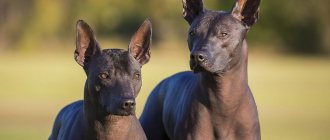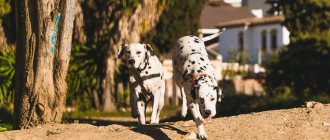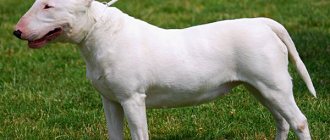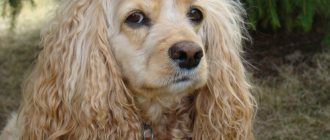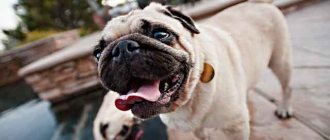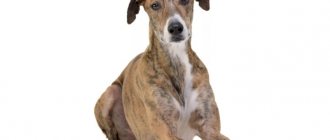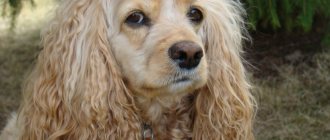In modern times, the Saint Bernard breed has gained popularity all over the world. You can see these giant dogs in many films.
Many people get such dogs without fully knowing their characteristics and features.
I wonder who these dogs are ideal for, and in what conditions it is possible and necessary to have them?
Description of the St. Bernard breed
Popularity 119th place among 263 dog breeds
Lifespan:
9-11 years
Breed group:
Service
Height:
males: 70-90 cm, females: 65-80 cm
Country of origin:
Switzerland
Average price:
25-35 thousand rubles
Weight:
from 70 kg
Latest articles Cat health
Rabies vaccination for cats: choice of vaccine, necessity, schedule 01/22/2022 20 0 0
Selection and adaptation
TOP 20 best cat breeds for families with children 01/22/2022 33 0 0
What to feed
The key to your pet's vivacity and healthy appearance will be a proper diet. It is important to follow the regime and not overfeed the St. Bernard, because he is prone to obesity. It is necessary that feeding is appropriate to the dog’s age, weight and height. When deciding what to feed your pet, it is advisable to consult a veterinarian and select the optimal food and products. A healthy dog's weekly diet should include the following:
- boiled and raw meat (horse meat, beef, lamb);
- processed offal (heart, liver, lungs);
- porridge (buckwheat, rice, oatmeal);
- vegetables, especially carrots;
- seafood;
- fermented milk products (kefir, cottage cheese);
- chicken eggs;
- raw or scalded sea fish, cleaned of large bones;
- bread;
- pasta.
Make sure there is always fresh water in a separate bowl for your pet. Don't give your dog sweets. When choosing what food to feed your pet, proceed from its age. Food for a pregnant or sick dog requires an increased concentration of beneficial vitamins and minerals. Your pet's menu should be complete and balanced.
Advantages and disadvantages
- Pros:
- soft character - dogs are calm, friendly, patient;
- excellent security qualities;
- pickiness in food;
- tolerance towards other animals;
- possibility of keeping in open space;
- silence - the dog will not bark unless there is a reason for it;
- responds well to training.
- Minuses:
- large size, which makes it impossible to keep a dog in a small apartment;
- drooling, especially in summer;
- the need for thorough combing during shedding;
- low life expectancy;
- walking a St. Bernard requires a lot of physical strength;
- Large body weight provokes destruction of the hip joints (dysplasia).
Attitude towards children and pets
Patient and gentle, they carefully let children put up with a lot. Always supervise any interactions between dogs and small children. Teach your child never to approach any dog while it is sleeping or eating, or to try to take food from it. No dog should be left unattended with a child.
They get along well with other pets, especially if they were introduced to them as puppies. However, this giant dog breed may accidentally step on or push your small pet.
Key facts
Saint Bernards look menacing, but are actually peaceful. Dogs have opposite traits: moderate playfulness, discipline, peacefulness, and courage. Representatives of the breed easily become attached to their owners, love children, and if you pay due attention to their training, they will be able to come to the rescue in any situation. Saint Bernards often become the heroes of funny photos and pictures. The characteristics of the St. Bernard breed include positive reviews that can be found on any dog breeders forum.
The country of origin of the good giants is considered to be Switzerland, namely the Swiss Alps. The territory is characterized by a capricious climate. Saint Bernards (the breed does not have an abbreviated name) lived for a long time in the monastery named after Saint Bernard and rescued travelers buried under the snow. As you can easily guess, the name of the breed came from the name of the monastery.
The description of the Saint Bernard breed says that these are large-sized animals, their minimum weight is 70 kg, the height at the withers (height) for females varies from 65 cm to 80 kg, for males - from 70 cm to 90 kg. The life expectancy of the St. Bernard is relatively long - both the male and the female live from nine to eleven years.
The minimum price for a purebred, healthy, vaccinated puppy according to the veterinary calendar is 25,000 rubles. The St. Bernard bought for this money has a mark, the RKF metric. The cost of the future exhibition winner ranges from 45,000 to 50,000 rubles. Also, puppies are sold on the Internet for “pennies” without required documents, but with a decrease in price, their purebredness is lost.
Main characteristics
Switzerland is considered the birthplace of St. Bernards. They appeared in this country in the mid-seventeenth century. They are characterized by an affable and kind disposition, seasoned with courage, loyalty and heroism.
The weight of St. Bernards ranges from 70-100 kilograms, and the height is between 65-90 centimeters. On average, St. Bernards live no more than eleven years.
The color of this breed comes in several shades: golden, orange and brown. Some Saint Bernards may have small black spots, which are in no way considered a sign of marriage.
Representatives of the St. Bernard breed have good mental abilities. They are obedient, disciplined, responsible and attentive.
Saint Bernards cope well with search tasks. And even in the absence of specific teams, they are able to make decisions independently and show ingenuity.
History of the origin of St. Bernard
This breed has a surprisingly long and complicated history - it is still not clear who the ancestors of the heroic dogs were. There are two theories regarding their origin.
It is believed that St. Bernards are descended from Tibetan Great Danes. They had a massive body and lived in the territory of Central and Asia Minor even before our era. Perhaps they came to the mainland thanks to Alexander the Great. Another version is that St. Bernards appeared as a result of mixing the Mastiff and Great Dane breeds.
The breed was named after the monk Saint Bernard, who founded a monastery in the Swiss Alps and set up a shelter for surprisingly intelligent and trainable dogs. The pass where he was located was distinguished by steep slopes and harsh climate; travelers often fell under avalanches, which is why the inhabitants of the monastery helped them instead of serving God.
In the 17th century, the animals, resistant to cold due to their dense undercoat and large body mass, began to help in the search for people. Saint Bernards were easily able to “predict” avalanches thanks to their excellent sense of smell. In addition, the dog was an excellent “quilted jacket” and helped the unlucky traveler stay warm until people arrived.
The nineteenth century was marked by the almost complete extinction of St. Bernards due to an unknown infection, and priests, in an attempt to endow the dogs with new qualities that increased survivability, began to cross them with representatives of the Newfoundland breed. The offspring of representatives of two different breeds looked more impressive, had long fluffy hair, but because of this they were completely unsuited to life in the snowy mountains. The monks released the long-haired dogs into the valleys, where they became watchmen, and left the short-haired dogs at the monastery.
The whole world learned about St. Bernards in 1887, when they were included in the breed register, where the “standard” of the breed is indicated, while they came to the USSR only after the Second World War. Before perestroika, several breeding individuals were used by dog handlers to create new breeds, and families were happy to have good-natured giants.
In the dangerous nineties, preference began to be given to daring and angry dogs, but the good-natured giants “returned” to Russia in 1996 thanks to the “National Club of St. Bernard Fans.” His goal was to preserve the breed, improve its qualities and gradually “reach” the masses.
Nutrition
With the diet of a one-month-old puppy, everything is simple: the new owner must feed him the same food that was provided to him by the St. Bernard nursery or breeder. Simple rules that a dog must unconditionally follow: feeding occurs at the same time, food can only be obtained in its own bowl.
A piece of food can be served by the owner by hand. This is the only exception to the feeding rules. It allows you to establish closer contact between the owner and the animal and promotes success in learning and training.
A difficult to achieve, but very important taboo regarding nutrition is not to pick up food from the floor or ground. Mastering this prohibition will save the dog’s health or even life. In the first months of life, the dog is fed 5-6 times a day. The number of feedings per year is reduced to 3. At the age of two, the dog can be fed twice a day.
The amount of food is determined in accordance with the condition and physical activity of the puppy. If the food is not completely eaten, the portions are reduced. If the puppy licks for a long time and does not move away, the portions increase slightly.
The basis of the diet is protein foods. Its best embodiment is raw meat. A one-month-old puppy is required 160-200 g per day. Gradually, meat consumption increases and by the year it can reach up to 0.5 kg.
Meat of various origins is suitable (beef, lamb, horse meat), but it should not be fatty. Offal is an excellent food: lung, heart, udder. Kidneys are a healthy product, but due to the pungent odor, the dog may refuse such food.
Fish is a very significant component of the St. Bernard's diet. It can even completely replace meat. But to satisfy the need for protein, it will require one and a half times more. Usually the fish is cooked briefly.
To improve digestion, the puppy receives fermented milk products from the age of six months. To enhance the mineral and vitamin component, seafood products are often included in the diet. After eating, the dog is given bones. It is desirable that they contain a large amount of cartilage. Calcium is vital for such a large dog.
Appearance of St. Bernard
What does this big stuffed dog look like? In the photo, the St. Bernard appears to be huge, and indeed, representatives of the breed are considered giant dogs: a male can reach a height of 90 cm, a female - 80 cm; “boy” and “girl” must weigh at least 70 kg. There are two types of dogs: long-haired and short-haired. In any case, the animal's fur will be soft and shiny.
Head
The skull is massive, wide and rounded. The middle part of the head is crossed by the frontal groove. The muzzle is moderately wide. The occipital protuberance, brow ridges, cheekbones, and feet can be called well developed. If the dog squints, noticeable folds appear on the forehead. Characterized by a black square nose with large nostrils, dense dark lips, massive jaws, moderately deep-set eyes of any shade of brown, wide-spaced triangular ears of medium size.
Neck
Saint Bernards have a long, strong neck with a dewlap; Some dogs have too much dewlap, which is a disadvantage.
Torso
The body is strong and muscular. The chest is moderately deep, the stomach is tucked towards the ischial tuberosity, the back is wide, the croup is long, smoothly turning into the tail. The withers are well defined.
Forelegs
The front legs are parallel to each other, straight and set wide apart. The shoulders are quite muscular, longer than the sloping shoulder blades. The forearm and shoulder are the same length. Elbows fit tightly to the body.
Hind limbs
The hind legs are widely spaced and parallel to each other. The thighs are strong and well developed, the buttocks are wide. The knee joints cannot be considered turned either inward or outward. Characterized by a strong hock joint and straight metatarsus.
Tail
The St. Bernard's tail is wide at the base and heavy. When standing, the St. Bernard can lower it to the hock joint. The tail hangs down, slightly curving upward. If the dog is excited or alarmed, the tail rises a little higher.
Movement
Despite their dense build, the movements of St. Bernards are smooth. The limbs move “along the line”, the back remains motionless. At the exhibition, the dog needs to move at a trot, because thanks to this it is possible to detect a defect - a shift in the center of gravity.
Wool
There are two types of Saint Bernards - short-haired and long-haired. Short-haired individuals have a dense undercoat, their thighs and tail are covered with short hair. Long-haired animals have long, slightly wavy hair, and their undercoat is very thick. The fur on the paws, hips and tail is especially luxuriant.
Color
What colors characterize the colors of the St. Bernard? The traditional color is white with large spots and a “cloak” on the back and sides. The inclusions, starting with a red tint and ending with a mixture of red-brown and brindle, are considered normal. The presence of a black edging on the head and a black symmetrical mask are welcome. It is considered mandatory to have marks on the forehead, chest, paws, scruff and tip of the tail.
Size
The size of the St. Bernard is enormous (it belongs to the giant breeds), and this makes keeping the dog in an urban environment problematic. A one-month-old puppy already weighs 3-4 kg, and its height ranges from 25 to 28 cm. There is nothing to say about an adult animal - the minimum weight of a St. Bernard tends to be 70 kg (a male weighs from 80 to 105 kg, a female from 70 to 80 kg), and the height of St. Bernard is from 70 to 90 cm! Immobility has a detrimental effect on the dog’s health and emotional state. A small cottage may be the right place to keep it.
Typical diseases of the breed
Thanks to genetics, dogs are resistant to aggressive weather conditions and have strong immunity. Six hay protects against wind, moisture, and mechanical stress, but dogs do not tolerate heat well, especially long-haired breeds.
St. Bernards reach large sizes in growth
Saint Bernards have a healthy body and recommended vaccinations significantly reduce the risk of possible infectious diseases, but this is not the problem of this breed. Despite a strong skeletal frame and powerful muscles, heavy body weight has a detrimental effect on the health of the joints. Therefore, high-intensity or forceful exercise is contraindicated for dogs.
If you suspect a joint disease, you should immediately contact a veterinarian and protect your dog from stress, otherwise there is a risk of joint dysplasia or bone cancer. The most common problems are Wobbler's disease or herniated vertebral discs, which arise due to improper care and nutrition of the animal.
Treatment of these diseases is only possible through surgery, but dogs can easily tolerate such operations. If the dog has difficulty turning around its axis, you should immediately consult a doctor.
Saint Bernards practically do not freeze in winter
St. Bernard's character
If you have a St. Bernard, be prepared for the fact that this giant will be cramped in the apartment, which will make the dog less emotional. On the street, an adult animal will explore the world with interest. The character of the St. Bernard is phlegmatic by nature, and while puppies sparkle with emotions, adult dogs are distinguished by sedateness and importance.
Despite this, animals need to be surrounded by people who give them love, affection, understanding and tenderness; They are close to enthusiasm, they love to play outside in winter, having fun wallowing in the snow. The character of St. Bernards is characterized by the appearance of a rare melancholy, passive rather than active rest and, despite this, interest in everything that happens nearby.
Who is a St. Bernard dog suitable for? For a family person, because at home, alone with the owner, they behave more relaxed. Dogs of this breed can become a loyal friend to their owner, a caring nanny (children are not at all a burden to these giants), and first-class house watchmen. Other animals do not disturb the dog at all, nor do strangers. But at the same time, the giant can become a reliable guard if necessary.
Breeding history
The name "Saint Bernard" stands for "dog belonging to Saint Bernard" in French. St. Bernards got their name thanks to a Swiss monastery that served as a shelter for travelers. The first representatives of this breed lived there
The monastery of St. Bernard was located high in the Alps, where avalanches were not uncommon. Therefore, the monks decided to use their dogs to rescue victims of mountain collapses. And St. Bernards had precisely those qualities that were supposed to help them in this difficult and responsible task: thick skin that protects from low temperatures, a developed sense of smell, a strong physique and endurance. In addition, the St. Bernards sensed the approaching avalanche, which saved not only their lives, but also the lives of the monks who accompanied them. However, the Saint Bernards of the 17th century were different from those of today. Their dimensions were much smaller, which made the dogs more mobile and maneuverable.
Only at the end of the 19th century did dog breeders and breeders become interested in the breed. Due to the breeding of a pure breed that met certain standards, St. Bernards acquired a familiar appearance to everyone. Currently, this breed is used for guard purposes.
Education and training
Inexperienced dog owners think too late about training their pet and ask questions “how to educate”, “how to train” and “how to wean” only when the dog chews furniture, refuses to follow basic commands or growls when trying to put a muzzle on it.
Usually, raising and training St. Bernards begins no later than two months. By this point, the puppies have become smart enough to follow basic commands and endure short training sessions. At six months you need to accustom your dog to a muzzle. If you make training regular for a St. Bernard puppy, then the adult animal will happily perform exercise after exercise.
Saint Bernards are easily given all the basic commands: “Ugh!”, “Sit!”, “Next!” - except for fetching. If you offer the dog a treat, the command will be carried out more readily. In addition, you need to teach the puppy to tolerate “morning toilet” (rubbing the eyes, face, scratching) so that the adult dog reacts adequately to this.
A well-behaved, trained dog is sure to attract people's attention (in a positive way) no matter the season.
General information
History of the breed
The breed received its modern appearance in the seventeenth century, when the monks of the Swiss Alps began to involve the ancestors of the breed in the work of searching for lost travelers. Strong, resilient dogs with thick fur searched for pilgrims caught in snow storms, helped them get out of the icy captivity and warm up a little with the warmth of the big dog’s body until bipedal help arrived.
INTERESTING: initially the breed was bred exclusively by monks from the monastery on the Great St. Bernard Pass. Until 1880, St. Bernards could be considered endemic to the pass, but by the end of the nineteenth century the breed was still included in the breed register, and the exterior received clear boundaries.
There was no worldwide interest in the breed until 1992, but when the American-made film Beethoven was released worldwide, interest in the breed began to revive. Today, the St. Bernard breed is considered a companion breed; dogs are recommended to be kept in a house with a large surrounding area, for large families and farms.
Features of the exterior and health of the breed
An adult Saint Bernard is a large dog, with a proportional body and head structure. At the withers, males reach 90cm, and females 80cm. Greater growth is also allowed; it is not considered an unacceptable violation of the standard, but it is very important to maintain the proportionality of the animal’s entire body. The weight of representatives of the breed fluctuates around 70 kg. The breed is considered truly gigantic; the heritage of Tibetan mastiffs and Great Danes is expressed precisely in their size characteristics.
The average life expectancy of a St. Bernard is standard for large dog breeds - 9-11 years.
A well-built adult Saint Bernard is a dog with a large body and head with high-set ears, a wide forehead and a large black nose. The dog's body is muscular, hardy, the coat, depending on the type, is from 4 to 8 cm long. The Saint Bernard has very thick fur with a dense undercoat. The breed is classified as a red color, with a color variation from red-brown to yellow, the tail must have a white tip, and the chest must have a white collar or spot. A mask on the face and a white stripe on the forehead are allowed.
The jaw is powerful, with a classic scissor or pincer bite, the lips are dark. Eye color varies from hazel to dark brown. A distinctive feature of a purebred St. Bernard is his kind look. This feature was formed during the breeding of the breed and its original purpose.
The harmonious gait of representatives of the breed is inherent in their physique, so all joints on the limbs should have moderate articulation angles. The tail in a calm state can be raised by the last third; in an excited state the dog raises it, but throwing it over the back is considered a deviation from the standard.
Purebred St. Bernards have a number of exceptional deficiencies that may affect their future suitability for further breeding.
The list of such disadvantages includes:
- Disproportionality in physique,
- Short limbs
- Sagging or hunched back
- Missing teeth
- Tail curled over the back
- Light eyes,
- Disturbances in the smooth movement of the dog associated with the angles of the limbs,
- Light lips, nose, eyelids,
- Violation of color (absence of white markings and a collar on the chest, or entirely white individuals),
- curly wool,
- Aggressiveness.
IMPORTANT: all of the above defects are considered according to severity. Strongly expressed deviations discard the dog from the mating process and exhibitions.
The “classic” diseases of St. Bernard dogs include deafness and joint diseases. Also among representatives of the breed, entropion and blindness are more common. Other diseases are not related to the characteristics of the breed and can overtake the dog due to the conditions of detention no more often than representatives of other large breeds.
Character and basics of education
The character of the St. Bernard is distinguished by its balance and peacefulness. Despite their gigantic size, the dogs are very friendly, get along well with children and are completely unsuitable for security work. Representatives of the breed easily get along with other pets, so having another dog, cat, fox or raccoon dog in the house will not be a problem; they will not play together, but keeping each other company while lying on the carpet is fine.
The peculiarity of an adult St. Bernard is that they do not have a strict concept of “this is my master and I will listen only to him,” the dog is friendly with the whole family, follows the commands of all household members and is affectionate with everyone. But there is also one serious disadvantage in this - the dog, considering itself a member of the family on hollow grounds and fawning over all members of the household, will smear everyone with its drool. Therefore, if you are not ready to remove traces of dog saliva from all surfaces in the house every day, then think about whether the St. Bernard is exactly what your family needs.
INTERESTING: St. Bernards are good as nannies for children from 4-5 years old; the dog will not let the child get bored and will patiently participate in joint games.
At first glance, St. Bernards are phlegmatic, but in fact they always long to be involved in family activities and games in the yard. It is worth noting that the dog is suitable for home living; he will go out into the yard for a walk, satisfy his natural needs and play, but St. Bernards prefer to rest at home, preferably on their bed. Otherwise, one of the sofas will be occupied by your hairy giant.
St. Bernard training begins at three months. Puppies are often slow to follow commands, but this is due to the breed's innate desire to think things through. Remember, the breed was bred to search for travelers lost in the snow, and this requires caution and deliberation. Training, like other breeds, starts with the basic commands “fu”, “sit”, “come” and so on. Representatives of the breed have difficulty with commands to fetch certain things, so if your plans are to teach your pet these actions, then do such training daily until the result is strengthened in everyday actions.
IMPORTANT: St. Bernard is not an aggressive breed of dog, but it is still worth training to wear a muzzle in crowded places. Start accustoming your puppy to this accessory from the age of four months, practice wearing it in the yard or with guests, so in the future the dog will experience a minimum of stress if it is necessary to wear a muzzle.
Up to a year, you can limit yourself to home training, and after that the dog can be involved in training in kennel clubs. Socialize your St. Bernard, especially if you are planning a show career.
It is important to remember that an adult St. Bernard is non-conflict by nature, but still do not delay with his upbringing and training, after two years of age they are practically untrainable, which means they are not controllable in the house in matters of their pranks.
Health and disease of St. Bernard
Possible diseases
From birth, St. Bernards have excellent health, but over time, like people, they age, and diseases caused by heredity “come out” to the surface.
They may have congenital problems with their ears (sometimes puppies are born deaf), paws, and eyes. Usually problems arise with the musculoskeletal system, the functioning of the digestive organs and endocrine system, and eye health. They chase animals throughout their lives. The most common diseases in St. Bernards are:
- dysplasia (dislocation) of the elbow and hip joints;
- ligament ruptures;
- herniated discs;
- epileptic seizures;
- lymphoma;
- bone or blood cancer;
- eversion and inversion of the eyelids;
- cataract;
- metabolic disease;
- bloating;
- obesity;
- allergies (immune system reaction to food, viruses, insects, poor-quality vaccinations).
What should you do to get your pet to hold its tail like a gun? To prevent illnesses, it is advised to monitor the dog’s diet, do a “morning toilet” (comb the fur, wipe the eyes, face, nose, clean the ears); In addition, you need to monitor the condition of the St. Bernard's teeth and his sexual health.
Reproductive health
If the owner chooses not to breed the bitch, it is better to sterilize it (in this case the question will arise “what to feed a sterilized animal”). Often, breeders think about the offspring of their pet quite late, while the first mating of a female dog should occur no earlier than her second heat (the first comes at the age of 8-9 months) and no later than four years. If these conditions are not met, the animal’s health will be at risk: difficult pregnancy and childbirth, complications, the cost of treatment of which is high.
Hygiene
- The Saint Bernard is a clean dog. It is necessary to bathe when soiled with special shampoos. It is advisable to comb the coat every day with brushes or combs, and during shedding - 2-3 times. Make sure that no tangles form on the wool.
- Inspect your mouth and teeth for tartar. Brush your dog's teeth with tooth powder as needed. During the period of teeth change, increase the amount of foods containing calcium in your pet’s menu.
- Trim your dog's nails once every 2 weeks. Regularly inspect the paw pads for wounds and stuck foreign objects. It is necessary to trim the fur between the fingers to prevent tangles from forming.
- Clean your ears weekly with cotton swabs soaked in hydrogen peroxide.
- The “giant’s” eyes are prone to inflammation. Monitor the frequency of mucus discharge and wipe the area around your eyes with a damp cloth or gauze every time after a walk.
- Puberty in the breed occurs at the age of 18 months. When you have determined that your pet is ready for mating, you need to choose the appropriate pair for him. If you have never dealt with the issue of dog mating, then the best solution is to invite a specialist.
Features of feeding and diet
Saint Bernards are prone to obesity, so veterinarians often hear the question “what to feed the animal.” Starting from birth, you should carefully monitor your pet’s nutrition: choose good food or create a balanced diet that complies with the norms of proteins, fats and carbohydrates, and, if necessary, introduce vitamin complexes. Experts often advise purchasing a guide for feeding a puppy or a guide for feeding an adult St. Bernard so that inexperienced owners do not have any difficulties.
The choice of dry food is very important. For the first month, the puppy usually continues to eat the food introduced in the kennel. The age and weight of the dog determines what food to buy and how much to feed: puppies receive five or six meals a day, and adults receive two meals a day. How to feed a St. Bernard - food or regular food - depends on the owner.
Colors
The characteristics of the breed include two main colors.
- Spotted - dominant color - white. Red spots of any shade.
- Cloaked - the head and back are colored in a range from light yellow to bright red. The chest, paws, collar and tip of the tail are white.
The standard provides for the presence of black specks on the bridge of the nose. Mixed breeds and albino Saint Bernards are not breeding dogs and cannot be bred in clubs or kennels.
Maintenance and care
Saint Bernards require a lot of living space because they are very large breeds of dogs. The most pleasant thing for a dog will be to stay in a cottage with a fenced area or in a spacious apartment. What should be the care and maintenance of a St. Bernard? Dogs of this breed need grooming - care for their appearance, which includes trimming their fur and nails, examining their ears, and cleaning their mouth, in particular their teeth. Owners of amazing fur require careful care, especially during the molting period, which occurs two or three times a year. The amount of hair loss depends on the type of breed - long-haired ones are more susceptible to this than short-haired ones. For St. Bernards, professional care is preferable, but do not forget about regular brushing of your pet at home.
Characteristics and shades of wool
Short-haired St. Bernards are endowed with hair that fits tightly to the body with a weak undercoat. The tail has elongated hair.
Long-haired individuals have straight, medium-length hair with excellent undercoat. Wavy fur in the thigh area. Legs have moderate coverage. The tail is thick, wide, and has rich feathering on the front legs.
The key shade is white, on which brown large or small spots are vaguely located, or a uniform color on the back in the form of a cape.
Brown spots may have light highlights. The end of the tail is white. Most have a white neck and a symmetrical white mask.
Tips for choosing a puppy
How to choose a puppy if there are not so many kennels breeding St. Bernards, and some of them have fabulous prices? Consulting a dog handler and visiting exhibitions can help in this difficult matter.
- Consultation
. Some breeders offer consultations for an additional fee. Experts explain what healthy St. Bernard puppies should look like and adequately assess their appearance (soft coat, absence of problems with the eyes and musculoskeletal system). Often the buyer is asked to make sure that the parents do not have serious illnesses. For example, if the bitch and the dog did not suffer from dysplasia, then the likelihood of this disease manifesting itself in the puppy is low. - Exhibition
. A good choice would be to visit an exhibition, where you can get to know the breeder and his pet directly, and see how well the animal meets the breed standards.
The cost also depends on the completeness of the package of documents. The puppy must be sold with a puppy certificate, which can later be exchanged for a pedigree, and a veterinary passport.
Unique Features
The large size and sad look of a St. Bernard are not an indicator of a dog’s lack of high intellectual abilities. On the contrary, practice has shown that dogs are very smart and quick-witted.
Knowing how to act under the influence of a quick reaction, they have helped humanity more than once. For a family, St. Bernard means love, safety and protection. Having such a dog at home is very helpful. Even if the dog gets lost, it can quickly find its way home even after tens of kilometers.
The most popular dog names in alphabetical order with recommendations- Shar Pei - history of the breed, character traits, care and possible problems + 87 photos
- American Bulldog - history of the breed, appearance, specifics and characteristics, care (100 photos + video)
The genetically inherent strength of character of these dogs makes them help people and save them from troubles. However, they will never show signs of aggression or harshness.
Nowadays, purchasing a St. Bernard puppy is not difficult. The cost of a good puppy with all the documents from hand varies from 400 to 7000 rubles. But adopting a pet with a pedigree from a shelter will cost a little more - from 10,000 to 15,000 rubles.
The main thing is to be responsible for the life of the pet you have tamed.
The main thing is to provide your pet with comfortable and necessary conditions for normal life, as well as to choose the right diet.
How much does a Saint Bernard cost?
The price of a St. Bernard depends on the “purpose” of the animal and the urgency of the sale. Kennels usually sell three categories of puppies:
- Pet class
. The average price of a puppy not allowed for breeding due to the presence of serious defects in the exterior varies from 5,000 to 20,000 rubles. The seller is obliged to notify buyers of the severity of the defect. - Middle, or breed class
. A Saint Bernard with a minor defect will cost the buyer an average of 25,000 rubles. Such dogs participate in exhibitions and often take prizes. - Show class
. A dog of this level costs more than 30,000 rubles because it has a good gene pool; Breeders often leave such puppies in the kennel, because they will often take first places at shows.
A faithful friend, a reliable protector, a melancholic rescuer - all this is about the St. Bernard.
Happiness and comfort will always reign in the house where he lives. Do you like the article? 0
Buying a puppy
St. Bernard puppies are clumsy, funny little babies that look a little like bear cubs. You just want to pick them up and squeeze them.
Before you take your little friend home, you need to find out: what is the price of a St. Bernard? And where is the best place to look for puppies?
The average price for St. Bernard puppies is from 5 to 30 thousand rubles. It all depends on the class.
Walk
Adult animals are allowed to walk in any weather. Ideally, a dog should spend 3 to 4 hours a day outdoors (applies to apartment pets). Daily promenades are also organized for puppies, but shorter and only on fine days. It is better to start getting acquainted with the street with short five-minute exits, subsequently increasing their duration. In addition, babies living in apartment buildings should not be taken out for walks in the first months of life, but rather carried out, since due to constant descents and ascents of stairs, the animal may develop curvature of its limbs.
An important point: St. Bernard puppies are contraindicated in excessive physical activity while walking. Long runs and repeated jumps made by an animal can provoke deformation of the joints and also cause the formation of incorrect leg positioning.
It is not recommended to walk your pet immediately after eating: the dog should have time for afternoon rest and normal digestion of food. If the baby is reluctant to go outside, most likely he simply did not have time to rest properly after the previous walk. In this case, it is better to leave the puppy at home and postpone the “excursion” to another time. In the summer, St. Bernards suffer from the heat, so it is better to walk them before 12 noon or in the evening (after 17:00). It is better to walk babies on a harness with a leather leash. Adults are brought out wearing a collar, using a strong one and a half or three meter leash.

